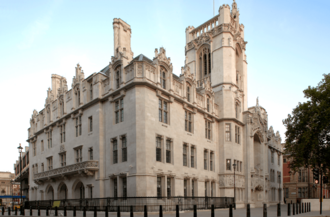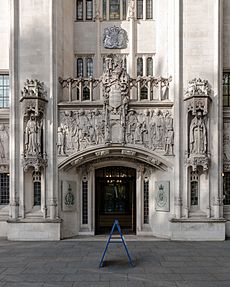Middlesex Guildhall facts for kids
Quick facts for kids Middlesex Guildhall |
|
|---|---|

The exterior of Middlesex Guildhall seen from Broad Sanctuary
|
|
| General information | |
| Status | Complete |
| Type | Court |
| Architectural style | Gothic revival with Flemish-Burgundian references |
| Address | Parliament Square City of Westminster SW1P 3BD |
| Town or city | London |
| Country | England |
| Coordinates | 51°30′01.5″N 00°07′40.8″W / 51.500417°N 0.128000°W |
| Current tenants |
|
| Construction started | 1906 |
| Opened | 1913 |
| Owner | Ministry of Justice |
| Technical details | |
| Material | Portland stone with slate roofing |
| Design and construction | |
| Architect | James Glen Sivewright Gibson |
| Other designers | Henry Charles Fehr (Sculptor) |
| Renovating team | |
| Architect | Feilden + Mawson supported by Foster and Partners (2007–2009) |
|
Listed Building – Grade II*
|
|
| Official name | Middlesex Guildhall |
| Designated | 5 February 1970 |
| Reference no. | 1226369 |
The Middlesex Guildhall is a special court building located in Westminster, London. It is home to the Supreme Court of the United Kingdom, which is the highest court in the UK. It also houses the Judicial Committee of the Privy Council. You can find this historic building on the south-western side of Parliament Square, very close to the famous Palace of Westminster. In 1970, this important building was officially recognized as a Grade II* historic site.
The building was constructed in the early 1900s. It was designed by a Scottish architect named J. S. Gibson. A British artist, Henry Charles Fehr, created its beautiful sculptures. The building is described as having a Neo-Gothic style, with influences from Flemish and Burgundian designs.
Originally, the Guildhall was an administrative centre for the local government of Middlesex County Council. It also served as a Court of quarter session, where less serious legal cases were heard. Later, it became a Crown Court, handling more serious criminal cases. In the early 2000s, it was chosen to become the home of the new Supreme Court of the United Kingdom.
History of the Middlesex Guildhall
The area where the Guildhall stands today was once part of Westminster Abbey. It was originally the site of the Abbey's belfry, which is a bell tower. The very first guildhall on this spot was built in 1805. It was designed by Samuel Pepys Cockerell and was known as the "Westminster Sessions House." This building was used by judges for the City and Liberty of Westminster.
In 1889, Westminster became part of the County of London. This meant it was no longer under the control of the county of Middlesex. When properties were divided between the Middlesex and London councils, the Westminster Guildhall went to Middlesex. This was in exchange for another building in Clerkenwell. Besides being a place for justice, the Guildhall also became the main office and meeting place for the Middlesex County Council. This happened after a new law in 1888 created county councils across England.
The leaders of Middlesex County Council soon realized that the first guildhall was too small. So, a second guildhall was built on the same site in 1893. This one was designed by F. H. Pownall in a neo-Tudor style.
However, the county leaders found that even the second guildhall was too small for their needs. Because of this, the current and third guildhall was built between 1906 and 1913. It was designed by J. S. Gibson. An expert in architecture, Nikolaus Pevsner, described its style as "art nouveau gothic." The building has a grand, balanced front with nine sections facing Parliament Square. The middle part sticks out slightly and has a fancy arched entrance. It also features a tall tower above. An old door from the 17th century, which used to be part of the Tothill Fields Bridewell prison, was placed in the building's basement. The building is decorated with medieval-style gargoyles and other sculptures made by Henry Charles Fehr.
After a new law in 1963, the Middlesex County Council and its courts were ended in 1965. But the Guildhall continued to be used by the Greater London Quarter Sessions. When the Quarter Sessions were abolished in 1972, the building became a Crown Court venue. However, the Guildhall stopped being a Crown Court after new courthouses were built in London during the 1980s and 1990s. These new courts included Harrow Crown Court and Isleworth Crown Court.
The Middlesex Guildhall was closed for renovations in 2007. The goal was to transform it into the new home for the Supreme Court of the United Kingdom and the Judicial Committee of the Privy Council. The Supreme Court officially began its work on October 1, 2009, after being created by a law passed in 2005.
See also


